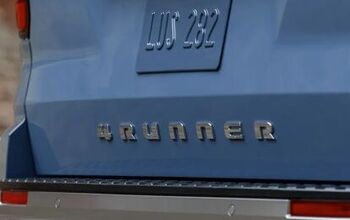Book Review: Crash Course: the American Automobile Industry's Road From Glory to Disaster
Predicted by site founder Robert Farago when few people thought it could actually happen, GM’s bankruptcy is now history. So, time for the histories.
Paul Ingrassia certainly seems qualified to provide one. The Wall Street Journal’s man in Detroit for years, he won a Pulitzer (with Joseph White) for his coverage of the auto industry’s early 1990’s brush with disaster and subsequent recovery. That coverage provided the basis for 1994’s Comeback: the Fall and Rise of the American Automobile Industry, a definitive account of that period.
Does Crash Course: the American Automobile Industry’s Road from Glory to Disaster similarly deserve a place on your bookshelf?
Well, it depends. Did you know:
- most Japanese cars circa 1970 were front-wheel-drive
- the Japanese invested in direct fuel injection in the 1980s
- Iacocca started the SUV boom with Jeep, and gave them the 4.0 engine
- the Saturn SL2 was larger than the SL1
- the Toyota Prius runs entirely on electric power below 30 mph
Of course you didn’t. When discussing cars, Ingrassia gets such facts wrong as often as he gets them right. So, should we wonder what else isn’t correct? Or should we grant that someone can know the car industry inside and out, without knowing cars?
The first 160 of the book’s 280 pages review the industry’s history from its roots through 2005, with an emphasis on labor relations. There’s nothing particularly insightful in them, and certainly nothing new.
The key point: the UAW, shaped through confrontation, and with a monopoly on the supply of labor, kept demanding more and more, and industry executives, lacking courage and in denial, accepted and appeased them. For example, GM executives might have been able to bankrupt the union in 1998, but ultimately “lost their nerve” because “the UAW was the devil GM knew.”
In 2005 the UAW successfully fought an attempt to ban smoking on the assembly lines. Ingrassia’s take: “the union often stood for the right to be irresponsible, and the company accepted the ridiculous.” The most damaging concessions: retirement after 30 years on the line and a “Jobs Bank” where displaced workers continued to receive nearly full pay. When a threat to the existing ways of doing things emerged in the form of Saturn, both management and labor successfully worked to kill it. Secondary points: industry executives were out of touch with the market, and product development funds were spread too thinly due to an excessive number of brands.
The book starts earning its purchase price once it reaches 2005. Though still not insightful, but it is at least mildly interesting. Rick Wagoner is criticized for making major blunders (the FIAT debacle, the failure to sell Saab and Hummer, GMAC home mortgages, huge financial and market share losses), yet refusing to make big changes, and continuing to believe that gradualism would work. Jerry York gets props for trying (without success) to make GM accept reality and take necessary steps to avoid bankruptcy. Cerberus and the executives it hired vastly underestimated the difficulty of fixing Chrysler, and were in way over their heads. Alan Mulally faced reality and did what needed to be done before it was too late.
The last two chapters are easily the best in the book. Heavily based on confidential interviews with the people involved, they start with the first Congressional hearings in late 2008 and end with the bankruptcies. We get positive portraits of the principal Presidential Task Force members, whose lack of industry experience, as with Mulally, proved to be an advantage. Lacking this experience, “they would ignore all Detroit’s conventional wisdom about what couldn’t be done and take their guidance from common sense instead of car sense.” They did know mismanagement when they saw it. The more Wagoner touted the Volt as the solution to the company’s immediate crisis, “the more Rattner and Bloom became convinced he was removed from reality.”
We get a somewhat detailed account of how the task force, with common sense and the courage to force major changes, squeezed all of the parties hard. It forced both management and labor to take steps that should have been taken years earlier. It forced debt holders to take major haircuts, because keeping the companies operating was the top priority. The “ridiculous” Jobs Bank? Finally gone. Non-essential brands? Gone. Mountains of debt? Gone. Wagoner? Gone. In short, “the task force had brought more common sense to GM than the company had seen in decades.” Government intervention was necessary because the UAW, company executives, and debt holders would never have worked out a solution on their own, even though (in the case of the first two) their livelihoods were at stake.
Crisis was always necessary to get the UAW and executives to make any changes at all, and even with a life-threatening crisis they weren’t willing or able to make sufficient changes on their own. So what, now, that the companies have been saved? In an afterward, Ingrassia doubts that the cultures of the UAW or the “lifer” executives who remained in control had undergone the needed revolutions.
The account throughout is very much that of a professional journalist. Unlike with Alex Taylor’s Sixty to Zero ( reviewed here), the personality and opinions of the author are well hidden. There’s minimal wondering what might have happened, for better or worse, if various people had acted differently. The exceptions: GM could have avoided bankruptcy if it had followed Ford’s lead, and Chrysler was nearly permitted to go under. But, once the decision was made to save both companies, what might have been done differently? What opportunities for change were missed? These questions aren’t asked, much less answered. The focus is on what did happen, on the (hopefully correct) facts.
The largest failing of Crash Course: it doesn’t dig much beneath the surface. Ingrassia’s new, shorter book (280 vs. 474 pages) is in general considerably less interesting and insightful than Comeback, which continues to be a joy to read. One likely factor: while the old book thoroughly delved into the biographies, work, and personalities of many mid-level managers, the new book focuses more tightly on harder-to-access people at the very top of the companies. (Two exceptions: a guy on the line and a car dealer.) Despite numerous interviews—they were “confidential,” and so are not listed—the major players remain caricatures. “Complacency, arrogance, and hubris,” “isolation,” a lack of “common sense,” and “lack of courage,” though certainly present, are the same, overly simple characterizations Detroit’s critics have been making since Brock Yates penned “Grosse Pointe Myopians” back in 1968. And probably before that.
These characterizations don’t go far enough. These people aren’t stupid; smart people somehow kept doing stupid things. Replace these smart people with other smart people, and more often than not the new people will do the same stupid things. Why does experience apparently suppress common sense? What were the UAW and corporate leaders actually thinking as events progressed? Why did they feel they had no choice but to act the way they did? Why are the “cultural revolutions” Ingrassia calls for still not happening?
The best answers Ingrassia offers: “courage” and the “common sense” of an outsider’s perspective. Both Mulally and the task force came from outside the industry, and so neither accepted that the way things had always been done was the way they had to be done. Beyond this, they had the courage to make big changes, and to face down those who opposed these changes—though both also appeased the union, if to a lesser extent.
Was “courage” truly the key difference between Wagoner and Mulally? And the courage to admit failure and step side the key difference between Wagoner and Bill Ford? Briefly mentioned: the Ford family and the priority it placed on retaining control through its stock ownership. Left implicit: while GM’s executives claimed until the last minute that bankruptcy was not an option, in Ford’s case bankruptcy was truly not an option. Perhaps this and not the courage of this or that individual explains why only Ford did whatever was necessary to avoid bankruptcy? Even though they held large amounts of stock and options themselves, perhaps GM’s executives did not feel the same amount of pressure to safeguard GM’s stockholders?
With his experience and contacts, Ingrassia should have been able to offer deeper, more thorough explanations for why the various players did what they did. Did he not try, or even in retirement does he remain bound by the culture of the mainstream auto media, and so unwilling to dig too deeply or say too much? Ingrassia criticizes the local Detroit media for “helping to create the very insularity that had made Detroit executives and UAW officials oblivious to the sentiment elsewhere in America.” The cultures of the UAW and executive suites are not the only ones still in need of revolution.
Michael Karesh lives in West Bloomfield, Michigan, with his wife and three children. In 2003 he received a Ph.D. from the University of Chicago. While in Chicago he worked at the National Opinion Research Center, a leader in the field of survey research. For his doctoral thesis, he spent a year-and-a-half inside an automaker studying how and how well it understood consumers when developing new products. While pursuing the degree he taught consumer behavior and product development at Oakland University. Since 1999, he has contributed auto reviews to Epinions, where he is currently one of two people in charge of the autos section. Since earning the degree he has continued to care for his children (school, gymnastics, tae-kwan-do...) and write reviews for Epinions and, more recently, The Truth About Cars while developing TrueDelta, a vehicle reliability and price comparison site.
More by Michael Karesh
Latest Car Reviews
Read moreLatest Product Reviews
Read moreRecent Comments
- Ollicat Another Biden attempt to say, "Look over there!"
- Kjhkjlhkjhkljh kljhjkhjklhkjh Who cares. Price of gas is not the issue. spending an extra 100$ a month over 4 tanks of gas is not the issue.this a political scam to distract really dumb people from the real issue. if rent and house payments were not up by 50% to as high as 150% higher in a ton of locations, then paying an extra 100$ in gas would be annoying but not really an issue. But the real-estate market with hedge fund investors, power-relator groups bought a ton of houses and flipped them into rentals and jacked up the rates uplifting the costs on everything else. and ironically no-one seems to be in any hurry to build more houses to bring those costs down because supply and demand means keeping less houses available to charge as much as you want. It is also not the issue as a secondary issue is child care costs and medical... again 100$ extra per month in gas is *nothing* compared to 800$ a month in ''child care'' and 300$ per visit to the doctor office, 300$ for a procedure less dentist trip..
- Ajla Is there something proprietary or installed on the moon with these that I'm not aware of?
- Tane94 Awaiting the EV3 unveil this month. Kia continues to lead, though I will miss the Soul
- Jeanbaptiste I know this will never be seen, but the real answer is NO Government mandated tech. The reason why is that when the government mandates something, we miss out on signals that the free market will give to weather or not people actually want this or that this tech would actually help. It's like mandating AM radio for cars when people could just buy a $10 am radio if they really like am so much.

































Comments
Join the conversation
Buickman - When Farago wrote that, he was essentially saying you made good points, but as with every conspiracy theorist, to take everything with you say with a grain of salt. Even a broken clock is right twice a day. The fact that you got a couple of things right about GM's meltdown doesn't make everything you say credible.
Only ostriches, fanbois, or the legally blind did not know GM was eventually doomed in the mid-70s. It was only a matter of time. From (as obbop noted) the Yates book in 84, back to On A Clear Day You Can See General Motors in 79, to the tons of subtle digs in the enthusiast rags of the day - WE ALL KNEW GM BK WAS INEVITABLE. I slogged through some of Ingrassia's tome, and between the inaccuracies, and there being nothing in there a well-read enthusiast wouldn't know, I quit after a hundred pages or so.